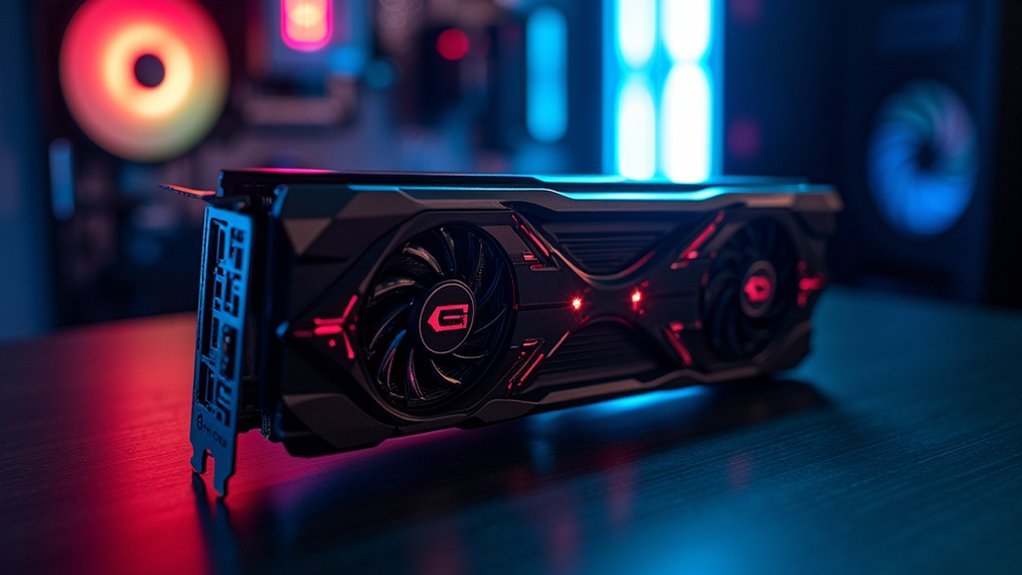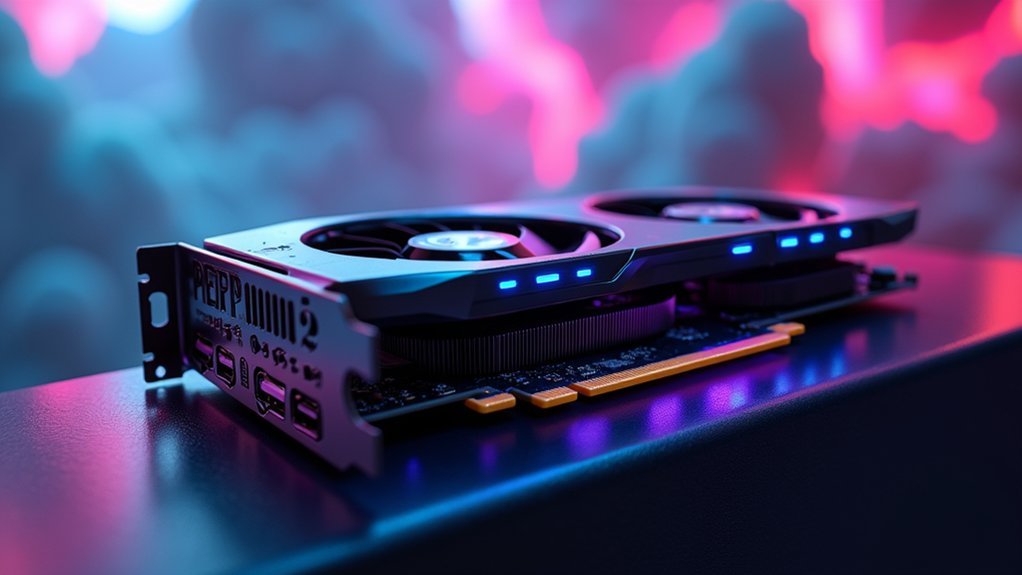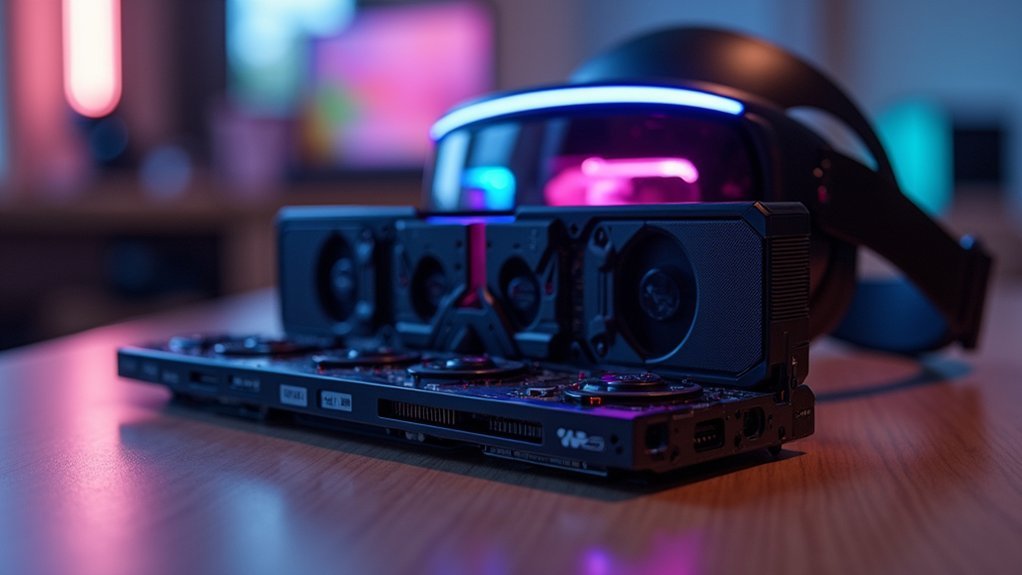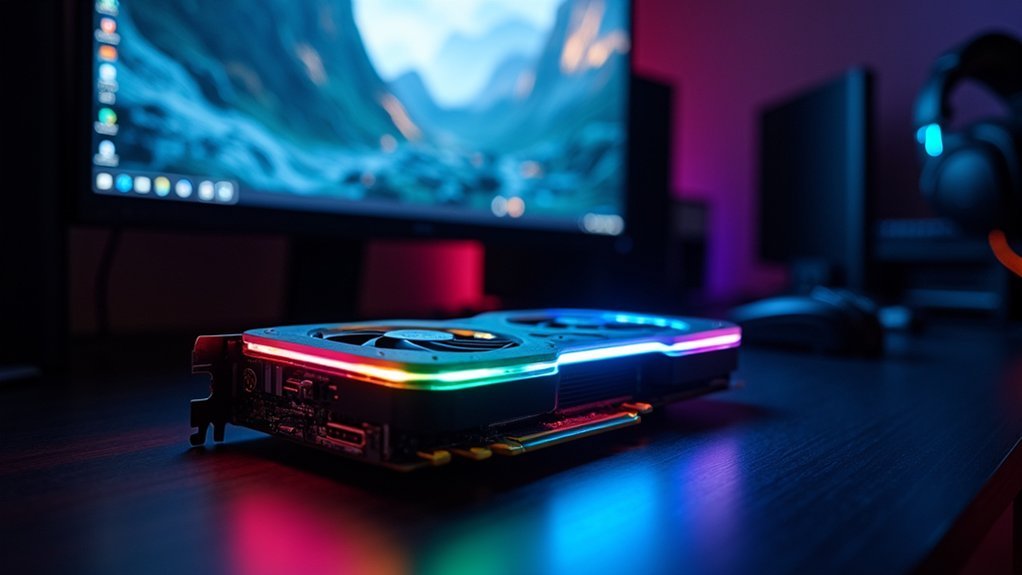You’ll need at least 12GB of VRAM for smooth high-resolution VR gaming, though 16GB or more provides better future-proofing. The RTX 4090’s 24GB GDDR6X and RTX 5090’s 32GB GDDR7 offer premium performance, while AMD’s RX 7900 GRE with 16GB delivers solid results. Memory bandwidth matters too—GDDR6X provides up to 21 Gbps, while GDDR7 reaches 32 Gbps for enhanced texture rendering and reduced latency. Understanding these specifications will help you choose the ideal configuration for your immersive setup.
Understanding VRAM Requirements for VR Gaming at 4K and Beyond

When you’re pushing your gaming setup to 4K resolution and beyond, your GPU’s VRAM becomes the critical bottleneck that determines whether you’ll experience buttery-smooth gameplay or frustrating stutters.
For 4K gaming, you’ll need a minimum of 8GB VRAM, though 12GB delivers superior performance. Higher resolutions demand exponentially more memory—4K requires four times the pixel data of 1080p.
Advanced gaming technologies like ray tracing intensify these requirements, often needing 10-16GB for peak texture handling. Insufficient VRAM triggers immediate performance drops, causing stuttering and frame rate issues.
Your graphics card selection should prioritize future-proofing, as upcoming titles will push VRAM demands even higher. Consider 12GB or more to handle next-generation games confidently.
Top Graphics Cards With Optimal Memory Configurations for VR
While VR gaming demands exceptional graphics processing power, selecting the right GPU with suitable memory configuration can make the difference between an immersive experience and a nauseating one. Here’s how top graphics cards stack up for high-resolution VR performance:
| GPU | Memory Capacity | VR Performance Level |
|---|---|---|
| Nvidia GeForce RTX 5090 | 32GB GDDR7 | Premium immersive VR |
| Nvidia GeForce RTX 4090 | 24GB GDDR6X memory | 4K/8K VR gaming |
| AMD Radeon RX 7900 GRE | 16GB GDDR6 | Enhanced texture detail |
| AMD Radeon RX 9070 XT | 12GB GDDR6 | Competitive VR settings |
These ideal memory configurations guarantee graphics-intensive applications run smoothly. The RTX 5090’s massive GDDR7 capacity delivers unparalleled performance, while budget-friendly options like Intel’s Arc B580 provide solid VR experiences without compromising essential features.
Memory Bandwidth Impact on High-Resolution VR Performance

Beyond raw memory capacity, bandwidth plays an equally important role in determining how well your GPU handles high-resolution VR environments. Memory bandwidth measures how quickly data transfers between your VRAM and processing cores, directly affecting GPU performance in demanding scenarios like 4K gaming and immersive VR experiences.
When you’re gaming at high-resolution, larger texture data and frame buffers can saturate your memory bandwidth, causing performance bottlenecks. The NVIDIA RTX 4090’s impressive 1,008 GB/s bandwidth exemplifies why this specification matters—it efficiently manages extensive data demands without compromising frame rates.
Advanced memory standards like GDDR6X provide superior bandwidth compared to older technologies, reducing latency and enabling faster texture data access. This becomes essential during rapid scene changes in virtual environments, where every millisecond impacts your immersion quality.
GDDR6X Vs GDDR7: Which Memory Type Delivers Better VR Experiences
How does memory type affect your VR gaming performance? The choice between GDDR6X memory and GDDR7 greatly impacts your immersive experience through data transfer rates and memory bandwidth capabilities.
GDDR6X currently delivers up to 21 Gbps, providing sufficient high bandwidth for 4K gaming and VR experiences. However, GDDR7’s anticipated 32 Gbps performance will considerably elevate your VR sessions.
GDDR7’s 32 Gbps capability represents a significant leap from GDDR6X’s 21 Gbps, transforming VR performance expectations.
Key differences you’ll notice:
- GDDR7’s enhanced memory bandwidth excels at rendering high-fidelity textures in complex VR environments
- Superior data transfer rates result in smoother frame rates during intensive gameplay
- Advanced encoding techniques in GDDR7 optimize efficiency beyond GDDR6X’s PAM4 technology
- Increased capacity handles larger datasets required for next-generation VR applications
GDDR7’s superior performance makes it the preferred choice for demanding VR experiences.
Future-Proofing Your VR Setup With Adequate GPU Memory Capacity

As VR technology rapidly evolves toward higher resolutions and more complex environments, you’ll need substantial GPU memory capacity to handle tomorrow’s demanding applications.
For current high-resolution VR setups, you should target GPUs with at least 12 GB of VRAM, though 16 GB or more provides better future-proofing against increasingly demanding titles.
GDDR6X memory guarantees peak performance when rendering graphics at 4K and beyond, maintaining the fluid frame rates essential for immersive experiences.
AI applications within VR environments will further strain memory resources, making advanced memory management techniques vital.
Don’t forget that future-proofing extends beyond your GPU—you’ll need balanced system architecture including powerful CPU and fast storage to prevent bottlenecks that could limit your high-capacity VRAM investment.
Frequently Asked Questions
What Is the Best Memory Type for a GPU?
You’ll want GDDR6X for gaming due to its cost-effectiveness and excellent performance. However, if you’re doing professional work like machine learning or 3D rendering, HBM offers superior bandwidth for demanding computational tasks.
Do You Need More VRAM for Higher Resolution?
You’ll definitely need more VRAM for higher resolutions. 4K gaming requires at least 8GB VRAM since you’re processing four times more pixels than 1080p, demanding considerably more memory for textures and frame buffers.
What Should My GPU Memory Be At?
You’ll want your GPU memory usage around 70-80% during intensive tasks. If you’re consistently hitting 90%+ utilization, you’ll need more VRAM to prevent performance drops and stuttering issues.
How Much VRAM Is Needed for Stable Diffusion GPU?
You’ll need at least 8GB of VRAM for basic Stable Diffusion tasks, but 12GB or more is recommended for complex models. For extensive training and high-resolution work, consider 24GB VRAM GPUs.





Leave a Reply